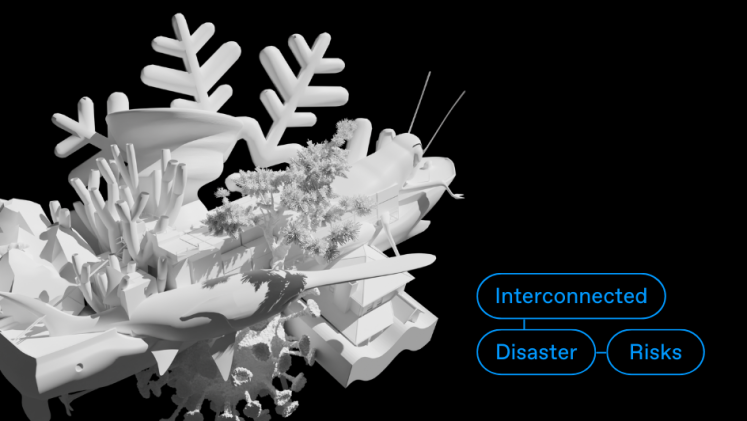Bonn, Germany 8 September – A new report, Interconnected Disaster Risks 2020/2021, was released today by United Nations University – Institute for Environment and Human Security (UNU-EHS). The report analyses 10 different disasters from 2020/2021 and finds that even though they occurred in vastly different locations and do not initially appear to have much in common, they are interconnected with each other.
As shown by the key findings of the recent IPCC 6th Assessment Report, extreme events, such as droughts, fires and floods, are increasingly compounding each other, likely as a consequence of human influence. Viewed through a lens of interconnectivity, this new report shows in detail how not only climate disasters, but human-made disasters in general build on the impacts of the past and pave the way for future disasters.
The frequency of severe weather events, epidemics and human-made disasters is increasing globally, and it is becoming ever more challenging to keep pace with the corresponding changes and impacts. In 2020/2021, the world witnessed a number of record-breaking disasters: the COVID-19 pandemic spread across the globe, a cold wave crippled the state of Texas, wildfires destroyed almost 5 million acres of Amazon rainforest, and Viet Nam experienced 9 heavy storms in the span of only 7 weeks. By analysing past events through the lens of interconnectivity, both the disasters that are happening right now and those that will happen in the future can be better understood.
“When people see disasters in the news, they often seem far away,” said UNU-EHS Senior Scientist Dr. Zita Sebesvari, a lead author of the report. “But even disasters that occur thousands of kilometres apart are often related to one another and can have consequences for people living in distant places.”
An example of this is the recent heatwave in the Arctic and cold wave in Texas. In 2020, the Arctic experienced the second-highest air temperatures and second-lowest amount of sea ice cover on record. The increasing temperature in the Arctic destabilizes the polar vortex, a spinning mass of cold air above the North Pole, allowing colder air to move southward into North America. Thus, changes in Arctic temperature influence locations far away from the Arctic and likely also contributed to the below-freezing temperatures in Texas, a state that is used to year-round warm weather. Around 4 million people were without electricity as the power grid froze up, and 210 people died.
Disasters also often occur simultaneously and compound each other, as happened with the COVID-19 pandemic and Cyclone Amphan in the border region of India and Bangladesh. In an area where almost 50 per cent of the population is living under the poverty line, the COVID-19 pandemic and subsequent lockdowns left many people without income options, including migrant workers who were forced to return to their home areas and were housed in cyclone shelters while under quarantine. When the region was then hit by Cyclone Amphan, many people, concerned over social distancing, hygiene and privacy, avoided evacuating to shelters and weathered out the storm in unsecure locations. The “super” cyclone in turn worsened the conditions for pandemic response in its aftermath, as health centres were destroyed and COVID-19 cases spiked in some areas. Amphan itself caused over 100 fatalities, damages in excess of 13 billion USD and displaced 4.9 million people.
Oftentimes, disasters stem from the same root causes, which means that they are interconnected by the same underlying factors that create the conditions for these seemingly unrelated disasters to occur. The new report Interconnected Disaster Risks identifies three root causes that affected most of the events in the analysis: human-induced greenhouse gas emissions, insufficient disaster risk management and undervaluing environmental costs and benefits in decision-making. Human-induced greenhouse gas emissions were one of the reasons why Texas experienced the freezing temperatures, but they also contribute to the formation of super cyclones such as Amphan, for example – an entirely different disaster in an entirely different part of the world. Insufficient disaster risk management was one of the reasons why Texas experienced such high losses of life and excessive infrastructure damages during the cold wave, and the same also contributed to the high losses caused by the Central Viet Nam floods.
But disasters are not only connected to each other; they are also connected to us as individuals. The record rate of deforestation and wildfires in the Amazon is in part due to the high global demand for meat: farmland is needed to grow soy, which is used as animal fodder for poultry. This means that some of the root causes of disasters are in fact influenced by the actions of people far away from where the event itself occurs.
“What we can learn from this report is that disasters we see happening around the world are much more interconnected than we may realize, and they are also connected to individual behavior. Our actions have consequences, for all of us,” said fellow lead author Dr. Jack O’Connor. “But the good news is that if the problems are connected, so are the solutions.”
The report showcases solutions at both the societal and individual level and explains how one action, such as cutting our greenhouse gas emissions, can affect many different types of disasters: it can prevent a further increase in the frequency and severity of hazards and protect biodiversity and ecosystems.
The ten disasters covered in the report are:
- Amazon wildfires – Wildfires fueled by global appetite
- Arctic heatwave – Spiraling into a climate disaster
- Beirut explosion – When the global community abandons a ship
- Central Viet Nam floods – When being prepared is no longer enough
- Chinese Paddlefish extinction – The fish that survived the dinosaur extinction but not humankind
- COVID-19 pandemic – How a pandemic is showing us the value of biodiversity
- Cyclone Amphan – When a cyclone and a pandemic combine
- Desert locust outbreak – How manageable risks spin out of control
- Great Barrier Reef bleaching – Losing more than a natural wonder
- Texas cold wave – A preventable catastrophe?
###
Notes to Editors
About United Nations University, Institute for Environment and Human Security (UNU-EHS)
Based in Bonn, Germany, UNU-EHS conducts research on risks and adaptation related to environmental hazards and global change. The institute’s research promotes policies and programmes to reduce these risks, while taking into account the interplay between environmental and societal factors. Research areas include climate change adaptation by incorporating insurance-related approaches, environmentally-induced migration and social vulnerability, ecosystem-based solutions to adaptation and disaster risk reduction, and models and tools to analyse vulnerability and risks linked to natural hazards, with a focus on urban space and rural-urban interfaces. UNU-EHS also offers the joint Master of Science degree programme “Geography of Environmental Risks and Human Security” with the University of Bonn and hosts international PhD projects and courses on global issues of environmental risks and sustainable development.
http://www.interconnectedrisks.org
Contact:
For visual assets or to set up a media interview, please contact:
Janine Kandel
Head of Communication
United Nations University Institute for Environment and Human Security
Phone: + 49 151 2672 1390 (mobile)
press@ehs.unu.edu
www.ehs.unu.edu
Dr. Nadine Hoffmann
Senior Communications Associate
United Nations University Institute for Environment and Human Security
Phone: + 49 228 815 0284
n.hoffmann@vie.unu.edu
www.ehs.unu.edu
Images for report coverage are also available here: https://bit.ly/IDRR21pics




![smart2[1].png](https://unu.edu/sites/default/files/styles/card_view_small/public/2024-04/smart2%5B1%5D.png?itok=_-ZcLOM5)